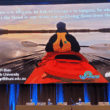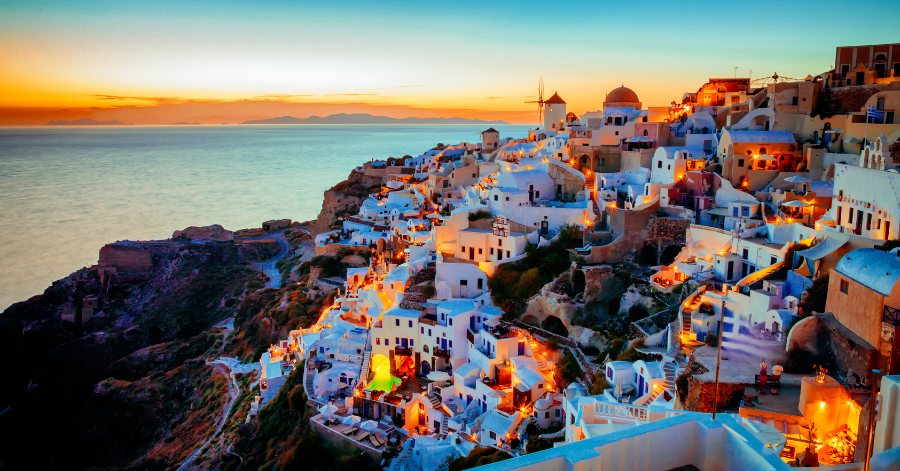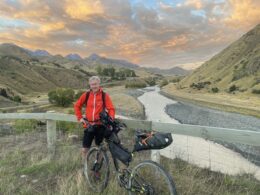In this first episode of Checking In, I reflect on recent examples of overtourism around the world. In particular, the news over the last few days that the mayor of Santorini has asked residents to “stay indoors” whilst the town is overwhelmed by visitors coming off multiple cruise ships to get their iconic Instagram sunset shots. But it’s not just Santorini suffering from this phenomenon. I consider what this means for tourism destinations elsewhere in the world.
If you’d like to receive email alerts when I publish new episodes, please sign up here.
You can read the full transcript of this episode below:
Three weeks ago on the 26 July on the Greek Island of Santorini, the local council issued a “stay at home” notice to island residents.
This advisory was issued in anticipation of a tsunami of cruise passengers that were expected to arrive on the island on that day.
The population of the island was expected to more than double due to the influx.
This led councillor Panos Kavallaris to advise residents to stay at home in a post on Facebook. In his post to said “Another difficult day for our island is ahead with the arrival of 17,000 visitors from cruise ships. We ask for your attention: limit your movements as much as possible.”
Local residents were understandably infuriated.
Meanwhile in the same week
In Barcelona protesters with water pistols were squirting water at tourists in cafes, and carrying placards reading “Tourists go home”, “You are not welcome” and “Your holiday, our misery”.
Similar protests have occurred across Spain this summer: from Malaga to Mallorca, the Canary Islands to Benidorm.
The media in Europe has reported that concerns for overtourism have evolved into ‘tourism phobia’.
Two important points arise from these protests:
1. Protest organisers across Spain have stated that the protests are not against tourists themselves, but rather a call for a more balanced approach to tourism
The frustrations of local residents are a response to the most obvious issues which include:
- Surging visitor numbers during the peak mass tourism season
- Crowding and congestion in destination communities
- Disruption of local lives
- And the behaviours of selfie-seeking tourists
But tourism is also seen to be exacerbating more deep-seated concerns:
- Soaring house prices and the inaffordability of housing is squeezing local residents out of the market
- The rise of short-term accommodation placing pressure on rental accommodation markets
- Changes in the social structure of communities are occurring with local residents being displaced by short term visitor rentals
- Changes in the spatial structure of communities with tourist services displacing businesses that serve local residents.
All of these things have added to the anxiety and frustration of people who are living in host communities
2. Protests against mass tourism are expected to become more widespread
Failure to address these issues could see the Spanish wave of protests against mass tourism extend across Europe.
Mass tourism has create situations that are “totally out of balance”.
There are strong calls now for governments and industry organisations to finds ways to manage tourism in accordance with physical and social impact thresholds of destination communities.
The challenges of overtourism are not unique to Europe.
In fact there are many parallels in this part of the world.
The overtourism phenomenon dates to the northern summer of 2017.
The term overtourism was coined in response to sustained and relentless high growth in international tourism in the years following the Global Financial Crisis in 2008-9 which came to a head in Europe in 2017.
Following the GFC New Zealand’s then prime minister John Key became the Minister of Tourism.
The government identified tourism as the key sector of the NZ economy that would lead the economic recovery in the years after the GFC.
And that is exactly what happened:
With initiatives such as the development of a national network of cycle trails to foster regional visitor activity, there followed a decade of sustained high growth in tourism through the 2010s.
By the time that COVID pandemic arrived, the Parliamentary Commissioner for the Environment Simon Upton was well advanced with a programme of research investigating the environmental impacts and social burdens of sustained high growth tourism.
Support for tourism in New Zealand – otherwise known as Social licence – was declining and the COVID-induced break in all tourism was received with relief in some quarters.
So-called revenge tourism has seen a rapid rebound to pre-pandemic levels of tourism in New Zealand’s popular tourism destinations. But the world has changed.
Despite the importance of tourism to the NZ economy, there is no doubt at all that sentiments towards unrestrained tourism growth have hardened since the COVID pandemic.
While recognising the importance of tourism for employment and income, local communities now demand careful management of tourism, in accordance with environmental thresholds and social constraints.
In Europe there is evidence of changes in response to local protests against mass tourism;
Santorini routinely sees more than 10,000 passengers a day disembark from cruise ships. In 2023 there were 63 peak days during which visitor numbers exceeded 10,000 or 11,000 passengers. Mayor Nikos Zorzos has suggested a cap of 8,000 a day.
- Denmark is pushing to encourage more climate-friendly, sustainable tourist choices
- Venice’s has adopted an entry fee to help manage demand.
- In Barcelona, the mayor recently vowed to curb apartment rentals to tourists by 2028.
- Mallorca and Dubrovnik have taken action to limit cruise ship arrivals.
- Amsterdam has actually closed its cruise terminal arguing that cruise tourism is incompatible with the city’s sustainability and climate mitigation goals.
But what is really needed is a paradigm shift:
The paradigm shift has been termed “localising tourism’ by some academics. This refers to the need for decision-makers to put the interests of local residents at the core of tourism planning and management.
This is evident in New Zealand with the development of Destination Management Plans by all 31 Regional Tourism Organisations in New Zealand.
This was required by the Ministry of Business, Innovation and Employment in 2021 to plan for the future when were emerged from the COVID pause.
MBIE required all DMPs to be informed by the sentiments and wishes of local residents and mana whenua. The starting point for tourism management is to ask how tourism can make matters better for local residents.
With the voices of local residents now embedded in DMPs, the challenge now is to fully and effectively implement those plans to ‘localise’ tourism.








